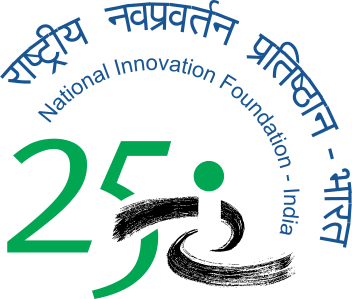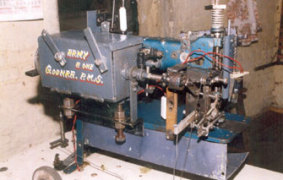Buttonhole Stitching Machine
Anil Rashmikant Kamdar (42) hails from Godhra, Gujarat. He has two sons who are studying in a district school. The family lives in a dilapidated rented house. Sharda, his wife, has been both his critic and confidanté and he would often call her to see his small feats during the making of the machine. After initial skepticism, she gradually gained confidence in his abilities and fervently hoped that his efforts would bear fruit. On many occasions, Sharda had helped him in his work, lifting machine parts, when he was unable to handle them alone.
Kamdar can read Gujarati and Hindi and a bit of English haltingly. He keeps himself updated on the latest happenings in the country. He has no other hobbies except using his creative imagination to make something new and of high utility. He hopes the money that he will earn from the machine will enable him to buy a house, invest in his children’s education and buy a bicycle for his sons (a long pending demand of theirs). He also wants to invest in aesthetic modifications of the design of the machine and spend the rest, in buying sewing-machine parts for his business.
Genesis
Five years ago, Anil Kamdar began toying with the idea of building a buttonhole machine. Considering he had little knowledge in designing machines, the task was challenging. So he started studying various parts of the sewing machine closely and their inter connections. He embarked on his mission to build a machine with a better thread cutting mechanism, a better gear mechanism, and an auto pump for lubricating several parts of the machine. In the year 1999, he began work on the machine. “While repairing sewing machines, I came across problems inherent in the Japanese and American versions of the buttonhole sewing machines. I did not copy these existing versions, but rather designed a different one, with newer functions and modes,” says Kamdar. He found a solution to an existing problem in machines that often led to the breaking of the thread.
His machine provides for the fully automatic sewing of buttonholes. It requires only the simple manual adjustment of one element to selectively determine buttonhole length prior to initiation of sewing. On an average this machine can do 100-120 buttonholes per hour. This low cost button-hole machine runs on a 0.25 HP, 2880 RPM electric motor. The length, width and spacing of the buttonhole for different fabrics can be varied at ease and calibrated with adjustment screws with automatic gear change lever to set different speed settings.
Salient features of the device
It is automatic with variable speed and auto lubrication facility (i.e. once set up for all parameters, it will perform the rest of operation automatically and calibration is comparatively easier because this can be done by adjustment of some screws).
It has lesser number of parts, so requires less maintenance and cost. e.g., a single power drive without any clutch is used in driving all the rotating parts of the machine.
Gearbox for the timer is located above the base plate unlike the conventional machine, for ease of operation.
It has a timer mechanism to allow easy shifting of gears to obtain different stitch patterns, by simply setting their sizes only. In all other machines the calibration is done automatically and hence the chances of failure are higher, whereas in Kamdar’s innovation the adjustments are done mechanically which tend to be more accurate.
A needle steering mechanism, which guides the needle along the width of the buttonhole with its zigzag motion as one cycle of stitching is completed. The translator causes motion of the pressure clamp along the length thus completing the buttonhole. The base plate, unlike the existing ones, remains fixed.
Acutter-unloader mechanism that gives flexibility of finding faults in the machine while the machine is running, thereby making the fault identification easy and accurate.
Unlike other machines, in this machine the base plate is high, so that all the mechanisms below the base plate are easily accessible and bobbin-shuttle adjustments can be done without much effort. For maintenance and adjustments, one need not lift the whole machine.
It has an auto stop mechanism to stop the sewing process when the needle or thread breaks. The machine stops the moment the thread or needle breaks. And one can re-start sewing from the point of the broken thread by adjusting the jog lever.
It has a counter for counting the number of buttonholes stitched. It has a light arrangement to enable working in nights with ease.
Easy thread handling as it is equipped with thread trimming, thread-tension and spring-loaded material clamping system.
Adjusting the ‘jog’ lever adjusts the needle to exact point of thread breakage.
The Ordeal
Anil took his savings, all of Rs 5,000, to buy various parts of the machine. He would commute long distances to work and while travelling he would spend time thinking about his machine. He would spend two hours every morning, and three to four hours in the evening tinkering and experimenting with his machine. “I struggled on getting the right functionality of the plate, over which the cloth moves while stitching. And this took me a quite a while,” says Anil.
His wife and relatives pressurized him to give up the idea, but instead he distanced himself from people, and even stopped attending Church on Sundays. Without electricity supply to his house at that time, he worked under the light of an oil lamp.
Months passed in many such experiments, and he soon wanted new machine parts. Since the parts were difficult to find in the market, he bought a hand-drill for about Rs 1,500, and began crafting the spare parts. For over two years, he worked with the hand drill- cutting, moulding and making the parts -as he wanted. He even used a small lid of a bowl, as a part of the machine. Kamdar’s enthusiasm was infectious and soon his wife began to assist him.
After Kamdar's savings got exhausted, he began using a major part of his daily income on his machine. He gave less than the normal amount to his wife, Sharda, for household expenses and even had to postpone his elder son’s schooling by a year. His wife argued that the amount of money he was wasting on the machine could instead have been invested in their children’s schooling. Soon bickerings gave way to pleading, but Anil ignored his wife’s persistent pleadings. They were on the verge of seeking a divorce but reconciled later. He sought help from friends and relatives at times, when he could not afford to sustain his family financially. But they used to ridicule his far-fetched dreams and turn him away.
It was this attitude of theirs that steeled his resolve to build the machine and prove them wrong. His determination, patience and confidence in his abilities kept him going. He dared to invest about Rs.4-5 lakhs from his meagre income, on making his dream a reality, over a period of four years inspite of severe family and financial pressures. In 2002, the machine was ready but he kept tinkering with it to improve its functions.
When he was confident that the machine worked well, he wanted to sell the technology. And so he wrote a letter to the Chief Minister of Gujarat and the Governor of Gujarat. The Chief Minister’s office advised him to contact the Industries Commissioner, who in turn asked him to contact a Patent Attorney in Bangalore. The Industries Commission, Govt. of Gujarat also contacted GIAN (Gujarat Grassroots’ Innovation Augmentation Network) and informed them about Anil Kamdar and a few days later, a representative from GIAN visited Anil Kamdar and documented his innovation. In early 2003, he was given financial assistance to improve and modify his innovation. The District Industries Centre of Godhra district also informed the media and a Zee News correspondent interviewed him in October 2002. He has also made a wooden model of a modified version of his prototype. The idea is to use this wooden design in calculating and designing better machine or its part the next time.
Current Status
The current prototype is very crude and suffers from the following limitations. Because of the play in the moving parts and components, the operation of the machine is noisy and mechanism heats up. The machine is big in size because components have not been optimized. The capacity of the machine at 100-120 buttonholes/hr is low as compared to the latest computer controlled machines having a capacity of around 600 buttonholes/hr. GIAN has filed a patent application on his behalf and has also sought the help of a sewing machine expert to modify the machine with the active involvement of Kamdar. His machine has since then been showcased at various exhibitions and workshops and a prototype is available at the GIAN office. GIAN is simultaneously on the look out for entrepreneurs, interested in manufacturing the machine commercially. Currently the Technopreunal Promotion Program (TePP) Scheme of the Department of Scientific and Industrial Research, has agreed to support the development of the prototype.
The first prototype has been designed to take care that the price of the final product is below Rs. 50,000 for automatic and Rs.20, 000 for manual versions. The number of moving parts is reduced and maintenance is extremely low.
An example to others…
Anil believes that patience and courage can convert ideas into reality. “I have never ever given up hope on anything ever since I was a child,” he says. His passion for innovating is evident when he reveals that he has also made a lock-stitch machine (used for stitching the hems of denim garments). He has completed the design for a button-stitching machine. He has also developed the design for a bicycle with gears which may travel at 50km/hr and will have greater pick up.
Questioning the prevalent attitude towards innovation, he says, “We Indians tend to have a kaam chalao (laid back) attitude and make do with whatever is available, without attempting to improve things. Innovations are indispensable if a country is to progress. Products from countries like USA and Japan are considered the best, why can’t we strive to be number one?” Difficult indeed for a man to understand whose dream is to contribute in every manner possible to the welfare of his countrymen.








